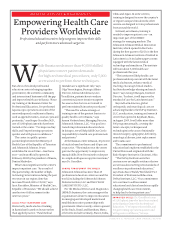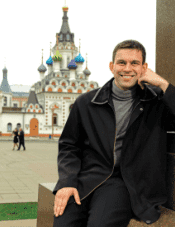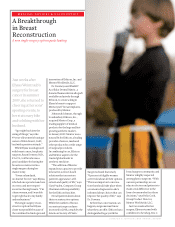Johnson and Johnson 2009 Annual Report Download - page 18
Download and view the complete annual report
Please find page 18 of the 2009 Johnson and Johnson annual report below. You can navigate through the pages in the report by either clicking on the pages listed below, or by using the keyword search tool below to find specific information within the annual report.
was initially approved for the treatment of
schizophrenia in the U.S. in and is
registered in more than countries
worldwide. Now Yoshino-san is doing well
with the medication, which is administered
every two weeks.
Long-acting
therapies that are professionally
administered allow for identification and
intervention when a dose is missed.
Patients and society can benefit when
non-adherence—which can lead to
relapse—is addressed.
For more than years, the Neuroscience
franchise has been committed to meeting
patient needs in the treatment of
schizophrenia. Once-daily ®
(risperidone), which was first approved in
, was a significant new option for
treating the symptoms of schizophrenia.
In , ® ® became
the first long-acting atypical antipsychotic,
oering every-two-week dosing. And
in , the U.S. Food and Drug Admin-
istration granted marketing approval for
® ™ (paliperidone
palmitate) extended-release injectable
suspension, the first atypical antipsychotic
with once-monthly maintenance dosing
approved for the treatment of schizophrenia.
“We’ve succeeded in a series of
innovations that build on our strong
heritage and long-term commitment to
meeting patient needs in schizophrenia,”
says Husseini K. Manji, M.D., F.R.C.P.C.,
Global Therapeutic Area Head,
Neuroscience, Johnson & Johnson
Pharmaceutical Research & Development,
LLC. “And we also continue to build strong
programs to treat other disorders with a
high unmet need for eective therapies.”
Alzheimer’s
disease is another devastating
neurodegenerative disorder. It is
diagnosed in more than million people
worldwide, and some estimates project
that number will quadruple by .
In September , Johnson & Johnson
completed the acquisition of substantially
all the assets and rights of Elan
Corporation, plc—a leading company
conducting both antibody and vaccine
research in Alzheimer’s disease—related
to its Alzheimer’s Immunotherapy
Program (AIP). The AIP includes multiple
compounds currently under evaluation.
The lead compound, bapineuzumab—
currently in Phase III clinical trials—is
being evaluated for slowing the
progression of Alzheimer’s disease. A
vaccine for Alzheimer’s disease is also
under development. The AIP compounds
are being developed through a
collaboration between Janssen Alzheimer
Immunotherapy and Pfizer, Inc.
Biomarkers, integrative informatics and
brain imaging are increasingly important
in researching neurodegenerative
disorders and developing solutions to
meet patient needs. “Such work cannot
progress in isolation,” says Dr. Manji.
“Collaborations and partnerships must
play a crucial role in arriving at
breakthrough solutions.”
For example, in October ,
Johnson & Johnson entered into a
strategic collaboration with Crucell NV,
focusing on the discovery, development
and commercialization of monoclonal
antibodies and vaccines for the treatment
and prevention of inuenza and other
infectious and non-infectious diseases.
The collaboration provides access to
technology and expertise in vaccine
development, which, along with the
Alzheimer’s disease vaccine program,
will enable a broad vaccine platform.
Pursuing the best science is part of an
innovation strategy to continue to meet
present and future patient needs.
“Solutions for the future may require
small and large molecules, devices
and diagnostics,” says Dr. Manji. “We have
all those pieces, plus a willingness to
collaborate with experts inside and
outside the company.”
“My schizophrenia symptoms are under
control,” Yoshino-san says. “
I feel my life
has a new beginning, and I wish the same
for others suering from this condition.”
Yoshino-san, ,
is one of million people worldwide who
suer from schizophrenia. The disease is
devastating for patients, their families and
society, and presents a significant burden
to health care systems.
Patients throughout the world share a
common need from drug therapy: delaying
time to relapse. Studies show that more
than percent of unmedicated patients
with schizophrenia relapse at least once
within the first five years of diagnosis, and
the primary reason for relapse is not
taking their medications as prescribed.
Yoshino-san was diagnosed a little more
than years ago. She was hospitalized
and eventually received treatment with
medication that gave her some relief from
the paranoia and voices haunting her
mind. She fell in love, got a job and
resumed a life she enjoyed. But eventually
it became harder for her to take her
medication each day as prescribed, and
she relapsed.
“All these new experiences all at
once pushed me over the edge, and my
condition worsened,” says Yoshino-san.
“I gradually began to skip taking my
medicines.”
She consulted her doctor, who
recommended changing to an
intramuscular injection, ®
® (risperidone), which was
granted approval by the Japanese Ministry
of Health in early and became
available in June. ® ®
Masako Yoshino once felt schizophrenia was like
a blizzard in her mind. But today, amid cold,
blustering snow in northern Japan, she finds
warmth and calm with a four-legged friend.
A treatment gives a schizophrenia patient the chance to
reclaim her independence.
16 JOHNSON & JOHNSON 2009 ANNUAL REPORT
























